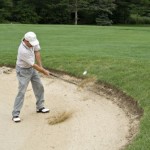“Golf is a good walk spoiled.” ~ Mark Twain
Although the web is overflowing with golf tips and golfer’s manuals, unfortunately not very many sources include the most basic and most important advice of all: Never and under no circumstances should you ever pick up the game of golf!
With warning signs of coffee cups and toothpastes, one can’t only wonder why are golf products not required the same responsibility to their customers-fallen-prey. With likely side-effects including marital problems, financial ruin, moral decay, nervous breakdown and heart disease, golf is indeed one of the most dangerous of human endeavors.
Being the responsible writer I am, I cannot help but introduce the following golf advice with a stern warning:
HAZARD: highly addictive. Do not attempt!
Sadly though, unless you have wandered over to this content by mere strike of bad luck, you are most likely past the usefulness of this counsel.
For that reason, we can only focus on symptomatic treatment, and attempt to alleviate the superficial pains and sufferings of your game caused by an incorrect golf swing plane.
Golf Swing Plane: What Is?
- The terminology of a swing plane comes from a golf teaching metaphor introduced by Ben Hogan in the 1950’s, in which he attempts to use the imagery of a plane/sheet of glass resting on the golfer’s shoulders at basic swinging position, leading at an angle towards the tee.
- In Ben Hogan’s initial interpretation, the glass plane formed an imaginary barrier, through which the golfer’s left arm (in case of a right-handed stance) should not penetrate at any stage of the swing. This meant to avoid steep left arm at backswing and finishing behind the right shoulder at the final position.
- In modern terminology, the golf swing plane refers to maintaining the correct swinging angle throughout the entire swing motion. A correct swing plane is among the most basic golfing skills and its mastery or lack thereof greatly affects the straightness, length and consistency of each shot. A golf glossary will tell you definitions of golf terms.
Golf Swing Plane: How To?
During each completed golf swing, the head of the club draws a halo or a circle around the golfer’s body. If we looked at this imaginary circle from behind the golfer, it would appear as a straight line leading at an angle from the backswing position to the ball.
In very simple terms, there are three aspects of maintaining a correct golf swing plane:
- Knowing the correct angle
- Maintaining the angle throughout the swing
- Being able to consistently repeat the motion in each swing
Stand in the proper swing stance, your club in the address position (that is at the contact with the ball). Imagine a hula-hoop lying along the top of your club’s shaft. During the swing, your club should follow the orbit of the hoop.
During practice, you should check your plane at two stages. First, when your arms reach your waist level and at the top of your backswing. In each case, start loosening the grip on your club. If the club begins to quickly slide out of your hands, you have not managed to maintain the correct plane.
As with any other golf skill, it will take hours and hours of driving range drills before your create the muscular memory of the correct motion. The main thing in golf swing practice is to ensure that you are creating the correct muscular memory. There are many tools available to accomplish just that. One of those tools (among many) is golf swing tempo drills.
Golf Swing Plane: Help Tools
Board
You can purchase or build your own golf swing plane board, which will allow you to slide your club at the correct angle in the first stages and in the middle of your swing, guiding your club to address the ball in the right position. More important tips that will help you are in the piece called golf swing balance tips leads to a great golf swing
Quarter
Since not being able to maintain the correct swing plane basically boils down to not being able to maintain a good balance throughout the motion, one way to practice this is to put a quarter or a coin ball marker on the tip of your front foot (that is left for a right-handed golfer). If the coin is still in its place at the completion of your swing, you are on a good road to maintaining the correct golf swing plane.



4 Comments
I have heard of the golf swing plane . I did not know exactly what it meant. In interesting concept.
I highly recommend the plane board. It really helped me with my swing in the beginning. -susan-
A friend introduced me to golf last year, and I agree, it is HIGHLY addicting, but I’ve met a number of fabulous people in this community because of it… so I wouldn’t trade it for the world. Never!
I never thought of the golf swing plane until I saw something about it on TV… Google brought me here and thank goodness. What a wonderful golf site. So specific but absolutely necessary if you ask me!